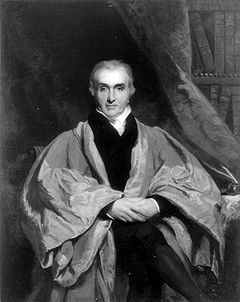Nationality Scottish Siblings Joanna Baillie Fields Pathology | Role Physician Name Matthew Baillie | |
 | ||
Alma mater University of GlasgowUniversity of Oxford Books The morbid anatomy of some of the most important parts of the human body Education | ||
Matthew baillie begbie
Matthew Baillie FRS FRSE FRCP FRCSE FRSE (27 October 1761 – 23 September 1823, Duntisbourne, Gloucestershire, England) was a Scottish-born physician and pathologist.
Contents
- Matthew baillie begbie
- This week in history season 2 episode 10 matthew baillie begbie
- Life
- Works
- References
This week in history season 2 episode 10 matthew baillie begbie
Life
He was born in Shotts Manse in Lanarkshire, the son of Prof Rev James Baillie and Dorothea Hunter. His sister was the poet Joanna Baillie. He was a pupil of his uncle, the anatomist John Hunter and his father-in-law, Dr. Thomas Denman, a pre-eminent obstetrician in London at the turn of the nineteenth century, whose textbook on childbirth had been first published in 1788. Baillie was educated at the Old Grammar School of Hamilton (renamed the Hamilton Academy in 1848), the University of Glasgow, and obtained his MD from the University of Oxford in 1789, having been named Snell Exhibitioner in 1779.
On his death in 1783 his uncle William Hunter bequeathed him £5,000, his house in Great Windmill Street, plus the adjacent medical school and museum. Baillie taught at the school from 1783 to 1803.
He then taught anatomy and was appointed Physician at St George's Hospital in 1789, but gave up both posts to establish his own medical practice in Grosvenor Square, becoming Physician in Ordinary to George III. He became Fellow of the Royal College of Physicians in 1790, specialising in morbid anatomy.
He was elected a Fellow of the Royal Society in 1790 and delivered their Croonian Lecture in 1791 (on the subject of muscles).
Baillie died of tuberculosis in 1823 in Duntisbourne at the age of 61 and was buried in Duntisbourne Abbots, Gloucestershire. He had married Sophia Denman, the sister of Thomas Denman.
Works
His 1793 book, The Morbid Anatomy of Some of the Most Important Parts of the Human Body, is considered the first systematic study of pathology, and the first publication in English on pathology as a separate subject. He is credited with first identifying transposition of the great vessels (TGV) and situs inversus.
